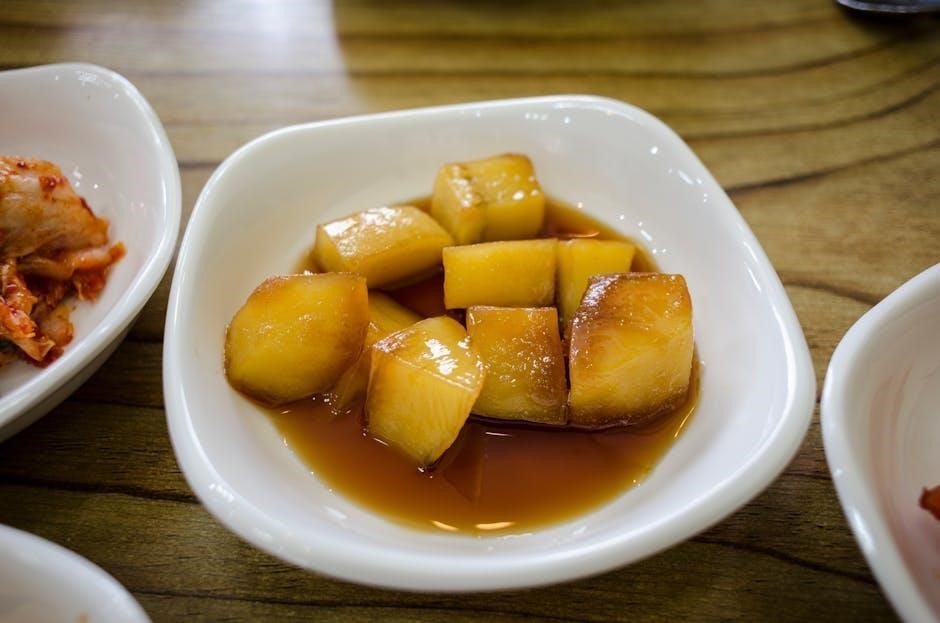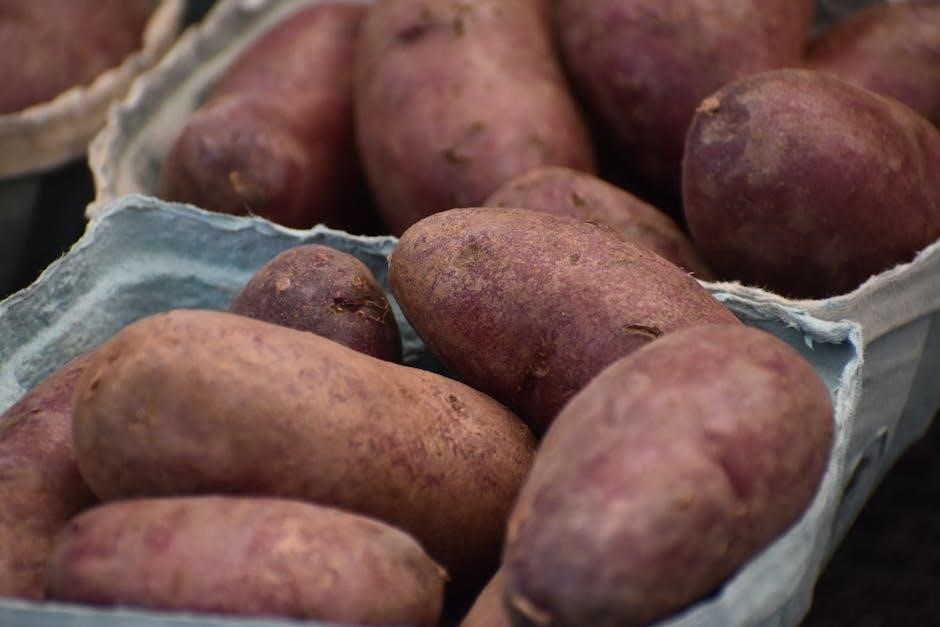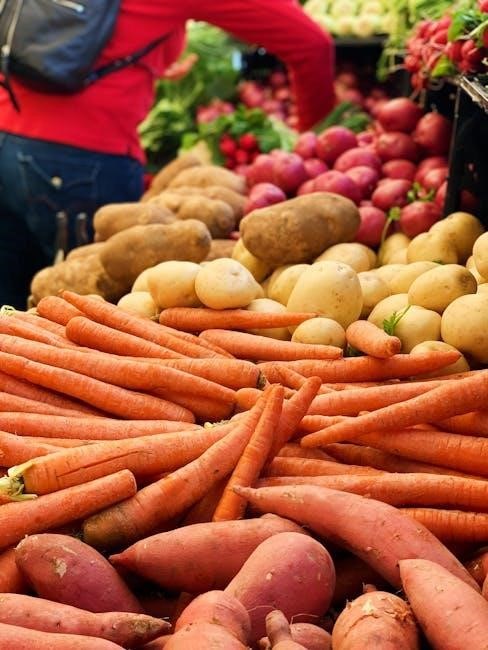Sweet potatoes are a versatile and nutritious root vegetable, scientifically known as Ipomoea batatas. They are a staple crop worldwide, offering rich nutritional benefits and culinary versatility.

1.1 What Are Sweet Potatoes?
Sweet potatoes are a root vegetable belonging to the morning glory family, scientifically known as Ipomoea batatas. They are tuberous plants with edible, starchy roots that vary in color, shape, and size. The flesh can range from white to deep orange, while the skin may be smooth or textured. Sweet potatoes are native to the Americas and have become a staple crop worldwide. They are highly adaptable, thriving in diverse climates and soils. Known for their natural sweetness, sweet potatoes are a versatile ingredient in both traditional and modern recipes, offering a delicious and nutritious base for dishes ranging from savory meals to sweet treats. Their popularity stems from their flavor, versatility, and ability to grow in various conditions, making them a favorite for home gardens and global cuisine alike.
1.2 Importance of Sweet Potatoes in Cuisine and Nutrition
Sweet potatoes are a culinary and nutritional powerhouse, offering exceptional versatility and health benefits. Rich in vitamins A and C, fiber, and minerals like potassium, they provide essential nutrients for overall well-being. Their natural sweetness makes them a versatile ingredient in both savory and sweet dishes, from traditional fries to modern recipes like baked goods and gluten-free flours. In cuisine, sweet potatoes add vibrant color, texture, and flavor, making them a popular choice for global dishes. Nutritionally, they support healthy digestion, immunity, and energy levels, while their antioxidants combat inflammation. Their adaptability and nutrient density make them a cornerstone in many cuisines, promoting balanced diets and culinary creativity worldwide.
History of Sweet Potatoes
Sweet potatoes, native to the Americas, have been cultivated for over 7,000 years, originating in the Andean region. They were a staple crop for ancient civilizations like the Incas.
2.1 Origin and Early Cultivation
Sweet potatoes trace their origins to the Americas, specifically the Andean region, where they were first domesticated over 7,000 years ago. Indigenous communities cultivated them as a primary food source due to their adaptability and nutritional value. Early cultivation techniques involved simple tools and methods, focusing on loose, fertile soils. The crop thrived in diverse climates, from high-altitude regions to tropical lowlands, making it a staple across pre-Columbian societies. Its importance extended beyond sustenance, featuring in cultural and religious practices. These early practices laid the foundation for its global spread, showcasing the ingenuity of ancient farmers in maximizing its potential.
2.2 Spread of Sweet Potatoes Across the Globe
The sweet potato’s global journey began after Columbus’s voyages, introducing it to Europe in the late 15th century. By the 16th century, it reached Africa and Asia, where it quickly became a vital crop due to its adaptability. In Africa, it thrived in diverse climates, aiding food security. In Asia, particularly in China and India, it became a staple, especially during times of scarcity. European colonizers further spread it to the Pacific, where it became central to Polynesian diets. Today, sweet potatoes are grown worldwide, with major producers in Africa, Asia, and the Americas, highlighting their enduring importance as a versatile and resilient food source.

Nutritional Value of Sweet Potatoes
Sweet potatoes are rich in vitamins A and C, potassium, and dietary fiber, making them a nutrient-dense food. They also contain antioxidants like beta-carotene, promoting overall well-being.
3.1 Vitamins and Minerals in Sweet Potatoes
Sweet potatoes are packed with essential vitamins and minerals. They are an excellent source of vitamin A, provided by beta-carotene, which supports eye health and immune function. Vitamin C is also present, aiding in immune support and collagen production. Additionally, sweet potatoes contain potassium, which helps regulate blood pressure and promotes healthy muscle and nerve function. They are also rich in dietary fiber, manganese, and antioxidants like anthocyanins, which protect against oxidative stress. The vitamin E content contributes to skin health, while iron and zinc support blood health and immune function. Overall, sweet potatoes provide a balanced mix of nutrients, making them a highly nutritious addition to a healthy diet.
3.2 Health Benefits of Sweet Potatoes
Sweet potatoes offer numerous health benefits due to their rich nutritional profile. They are high in fiber, which aids digestion and promotes a healthy gut. The antioxidants, particularly beta-carotene and anthocyanins, help combat oxidative stress and reduce inflammation. Sweet potatoes support immune function through their vitamin C and A content, while potassium helps maintain healthy blood pressure. They are also low on the glycemic index, making them a great choice for managing blood sugar levels. Regular consumption may reduce the risk of chronic diseases like heart disease and certain cancers. Additionally, the vitamin E in sweet potatoes supports skin health, and their anti-inflammatory properties can help alleviate conditions like arthritis. Overall, sweet potatoes are a nutritious and versatile food that supports overall well-being.
Different Varieties of Sweet Potatoes
Sweet potatoes come in various types, such as Jewel, Garnet, and Covington, each differing in color, texture, and flavor, offering diverse culinary and cultivation options.
4.1 Common Types of Sweet Potatoes
Sweet potatoes are available in several common varieties, each with distinct characteristics. Jewel and Garnet are widely recognized for their deep orange flesh and sweet flavor, making them ideal for roasting and mashing. The Covington variety is another popular type, known for its high yield and resistance to diseases. These varieties are not only delicious but also versatile, suitable for a wide range of recipes. Whether you prefer them baked, fried, or boiled, each type offers a unique taste experience. Understanding these common types can help you choose the best one for your culinary needs and growing conditions.
4.2 Unique and Exotic Varieties
Beyond the common types, sweet potatoes come in unique and exotic varieties that offer distinct flavors and textures. The Okinawan sweet potato, with its vibrant purple flesh, is prized for its antioxidant-rich profile and sweet flavor. The Hannah variety boasts white flesh and a sweet, nutty taste, while the Purple Peruvian stands out with its deep purple skin and earthy sweetness. These exotic varieties often have specialized growing conditions and are sought after for their bold characteristics. Incorporating these into your dishes can add a unique twist to traditional recipes. Exploring these lesser-known types allows for culinary creativity and diversifies the sweet potato experience.
Growing Your Own Sweet Potatoes
Start with certified disease-free slips, plant in raised mounds, and ensure loose, well-draining soil with a pH of 5.8-6.5. Space plants 12-18 inches apart for optimal growth.
5.1 Choosing the Right Variety for Your Climate
Selecting the right sweet potato variety for your climate is crucial for a successful harvest. Popular varieties like Jewel and Garnet thrive in warmer climates with long growing seasons, while others, like Hernandez, are more adaptable to cooler conditions. Consider the maturity period, as some varieties require 90-120 days to mature, making them unsuitable for shorter growing seasons. Additionally, certain types, such as Beauregard, are drought-tolerant and ideal for drier climates. For unique flavors, explore varieties like Okinawan (purple-fleshed) or White Delight (white-fleshed). Always check the specific needs of the variety, including temperature and soil preferences, to ensure optimal growth in your region.
5.2 Soil and Weather Requirements for Growing
Sweet potatoes thrive in well-draining, loose soil with a pH between 5.8 and 6.5. They prefer sandy loam or fine sandy soils, avoiding heavy clays that can cause rot. Ensure the soil is free of rocks and weeds to promote healthy root development. Weather-wise, sweet potatoes require warm temperatures, with ideal daytime highs of 75-85°F (24-29°C) and nighttime lows above 50°F (10°C). Adequate moisture is essential, especially during the first few weeks after planting, but overwatering should be avoided to prevent disease. Full sun is necessary for optimal growth, and the crop is relatively drought-tolerant once established. Planting in late spring or early summer, after the soil has warmed, ensures the best results.

Planting and Caring for Sweet Potato Plants
Plant sweet potato slips in late spring or early summer in raised mounds, spacing them 3 feet apart. Water thoroughly and ensure full sun for optimal growth.
6.1 When and Where to Plant Sweet Potatoes
Plant sweet potato slips in late spring or early summer when nighttime temperatures consistently exceed 50°F (10°C). Choose a location with full sun and well-draining, loose soil. In regions with cooler climates, start slips indoors 4-6 weeks before the last frost date. Ensure the soil pH is between 5.8 and 6.5 for optimal growth. Create raised mounds 6-8 inches tall and 12 inches wide, spacing them 3 feet apart to allow ample room for spreading. This setup promotes healthy root development and maximizes yield. Proper timing and site selection are crucial for a successful harvest, as sweet potatoes thrive in warm weather and well-drained soil conditions.
6.2 Watering and Maintenance Tips
Keep the soil consistently moist but not waterlogged, as sweet potatoes are susceptible to rot in overly wet conditions. Water deeply once or twice a week, depending on weather. Mulch around plants to retain moisture and suppress weeds. Avoid overwatering, especially in heavy soils, to prevent disease. Regularly inspect plants for pests like aphids and flea beetles, and control them with organic methods if necessary. Fertilize sparingly, as excessive nitrogen can lead to excessive foliage growth at the expense of tubers. Ensure good air circulation by maintaining proper spacing between plants. Monitor soil health and address nutrient deficiencies promptly for optimal growth and yield.

Harvesting Sweet Potatoes
Sweet potatoes are ready to harvest when the tops turn yellow. Carefully dig them up with a fork to avoid damaging the tubers. Handle gently for storage.
7.1 When to Harvest Sweet Potatoes
Sweet potatoes are typically ready for harvest 100 to 110 days after planting, when the vines begin to yellow and die back. Check for readiness by gently digging around the plants with a fork. The ideal time is when the soil temperature reaches 55-85°F, ensuring the tubers are mature and flavorful. In regions with a long growing season, harvest before the first frost to prevent damage. For areas with shorter seasons, plant early to allow sufficient maturity. Proper timing ensures the sweet potatoes are sweet and of high quality. Avoid waiting too long, as over-mature tubers may develop hard, inedible cores. Harvesting at the right time maximizes yield and flavor.
7.2 Techniques for Harvesting Sweet Potatoes
To harvest sweet potatoes, carefully dig around the plants using a fork, working 12-18 inches away from the stem to avoid damaging the tubers. Gently loosen the soil, then lift the sweet potatoes by hand or with a garden tool. Handle the tubers with care to prevent bruising or breaking. After harvesting, allow the sweet potatoes to cure in a warm, humid place (85-90°F with high humidity) for 7-10 days to heal any minor injuries and enhance flavor. This step is crucial for long-term storage. Proper harvesting techniques ensure minimal waste and optimal quality for both immediate use and preservation.
Culinary Uses of Sweet Potatoes
Sweet potatoes are incredibly versatile in global cuisine, featured in dishes like fries, chips, baked goods, and traditional recipes such as gulab jamun, offering both savory and sweet options.
8.1 Traditional Recipes Using Sweet Potatoes
Sweet potatoes have been a cornerstone in many traditional cuisines worldwide. They are often roasted, mashed, or baked, serving as a delicious side dish. In some cultures, sweet potatoes are used to make hearty stews and soups. One unique traditional recipe is sweet potato gulab jamun, where mashed sweet potatoes replace mawa, creating soft, flavorful dumplings soaked in sweet syrup. Additionally, sweet potato fries and chips are popular snacks, offering a crispy, savory treat. These versatile tubers also find their way into traditional baked goods, such as pies and breads, adding natural sweetness and moisture. Their adaptability makes them a staple in both sweet and savory dishes across the globe.
8.2 Modern and Creative Ways to Use Sweet Potatoes
Modern cuisine has embraced sweet potatoes in innovative ways, expanding their culinary potential. One popular trend is using sweet potatoes to make nutrient-dense flour, perfect for gluten-free baking. They’re also transformed into crispy chips or baked into loaded street fries, offering a tasty, macro-friendly snack. Additionally, sweet potatoes are used as a base for vegan burgers or blended into creamy soups. Their natural sweetness shines in desserts like sweet potato pie or cheesecake. For fitness enthusiasts, baked sweet potatoes are a great post-workout meal, topped with wholesome ingredients. Creative chefs even use them to make gnocchi or as a pizza crust alternative. These versatile tubers continue to inspire modern recipes, blending tradition with contemporary flavors and dietary needs.

Storage and Preservation of Sweet Potatoes
Store sweet potatoes in a dark, cool, humid place to maintain freshness. Preserve them by making sweet potato flour or dehydrating for long-term use in recipes.
9.1 How to Store Sweet Potatoes for Longevity
To store sweet potatoes effectively, place them in a dark, cool, and humid environment. Avoid direct sunlight and extreme temperatures. Store them in a breathable container or paper bag to maintain airflow. Do not wash before storing, as moisture can lead to rot. Cure sweet potatoes by keeping them in a warm, humid place for 7-10 days to heal minor bruises. Store at a consistent temperature of 55-65°F (13-18°C) for optimal longevity. Check periodically for signs of spoilage and remove any affected tubers to preserve the rest. Avoid refrigeration, as it can alter their flavor and texture. Proper storage can keep sweet potatoes fresh for several months.
9.2 Methods for Preserving Sweet Potatoes
PRESERVING sweet potatoes ensures year-round enjoyment of this nutritious crop. One popular method is making sweet potato flour, which can be done without a dehydrator by slicing, drying, and blending into a fine powder. Another option is freezing, where cooked, mashed, or roasted sweet potatoes can be stored in airtight containers for up to 6 months. Canning is also effective, using a pressure canner to preserve cubes or mashed sweet potatoes. Dehydrating thinly sliced sweet potatoes creates crispy snacks or chips, which can be stored in airtight containers. Additionally, pickling in vinegar and spices offers a tangy, long-lasting preservation method. Lastly, curing sweet potatoes for 7-10 days in a warm, humid environment helps heal minor bruises and extends storage life. These methods ensure sweet potatoes remain fresh and versatile for future use.

Health Benefits of Sweet Potatoes
Sweet potatoes are packed with fiber, vitamins, and antioxidants, supporting digestion and boosting immunity. They aid in managing blood sugar levels and promote healthy vision and skin.
10.1 Sweet Potatoes for Overall Health
Sweet potatoes are a nutrient-dense superfood, rich in vitamins A and C, fiber, and antioxidants like beta-carotene. These nutrients support immune function, digestion, and energy levels. Their high water content and low calorie count make them an excellent choice for weight management. The antioxidants in sweet potatoes help reduce inflammation and protect against chronic diseases. Regular consumption can improve skin health, enhance vision, and support healthy blood sugar levels. Additionally, they are a good source of minerals like potassium and iron, which are essential for maintaining overall well-being. Incorporating sweet potatoes into your diet can contribute to a balanced and healthy lifestyle, providing sustained energy and numerous long-term health benefits.
10.2 Sweet Potatoes for Specific Health Conditions
Sweet potatoes offer targeted benefits for various health conditions. Their high fiber content aids in managing diabetes by regulating blood sugar levels. The antioxidants and vitamin A in sweet potatoes support eye health, reducing the risk of macular degeneration. They are also beneficial for heart health due to their potassium content, which helps lower blood pressure. Additionally, sweet potatoes contain anti-inflammatory properties that may alleviate symptoms of arthritis and other inflammatory conditions. Their nutrient-rich profile makes them an excellent choice for supporting immune function in individuals with compromised health. Incorporating sweet potatoes into specific dietary plans can provide tailored health benefits, making them a valuable addition for managing chronic conditions and promoting overall wellness.
Sweet potatoes are a nutritional powerhouse and a versatile ingredient in global cuisine. Their rich vitamin and mineral content, combined with their adaptability in recipes, makes them a valuable addition to any diet, promoting health and culinary creativity alike.
11.1 Summary of the Importance of Sweet Potatoes

Sweet potatoes are widely recognized as a nutrient-rich, versatile, and culturally significant food crop. They are packed with essential vitamins, minerals, and antioxidants, making them a powerhouse for health. Their adaptability in both traditional and modern recipes highlights their culinary importance, from savory dishes to sweet treats. Sweet potatoes also play a crucial role in food security, particularly in regions with challenging growing conditions. Their ability to thrive in diverse climates makes them a sustainable crop. Additionally, they are a key ingredient in various industrial products, further enhancing their economic value. Overall, sweet potatoes are a vital component of global cuisine, nutrition, and agriculture, offering numerous benefits for health, culture, and the environment.
11.2 Final Thoughts on Incorporating Sweet Potatoes into Your Diet
Incorporating sweet potatoes into your diet is a simple yet impactful way to enhance your health and culinary experiences. With their rich nutritional profile, including vitamins A and C, fiber, and antioxidants, they offer a natural boost to overall well-being. Whether roasted, baked, mashed, or used in innovative recipes like sweet potato fries or flour, their versatility ensures they can fit into any meal. Experimenting with traditional and modern recipes allows for endless creativity. Additionally, their sustainability and accessibility make them a practical choice for diverse lifestyles. Embrace sweet potatoes as a delicious and nutritious addition to your diet, and explore the countless ways they can enrich your meals while supporting your health goals.
